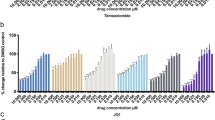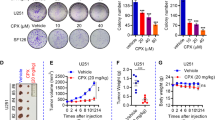Abstract
Inhibitor of apoptosis (IAP) proteins are expressed at high levels in many cancers and therefore represent attractive targets for therapeutic intervention. Here, we report for the first time that the second mitochondria-derived activator of caspases (Smac) mimetic BV6 sensitizes glioblastoma cells toward Temozolomide (TMZ), the first-line chemotherapeutic agent in the treatment of glioblastoma. BV6 and TMZ synergistically reduce cell viability and trigger apoptosis in glioblastoma cells (combination index <0.4–0.8), which is accompanied by increased loss of mitochondrial-membrane potential, cytochrome c release, caspase activation and caspase-dependent apoptosis. Analysis of the molecular mechanisms reveals that BV6 causes rapid degradation of cIAP1, leading to stabilization of NF-κB-inducing kinase and NF-κB activation. BV6-stimulated NF-κB activation is critically required for sensitization toward TMZ, as inhibition of NF-κB by overexpression of the mutant IκBα super-repressor profoundly reduces loss of mitochondrial membrane potential, cytochrome c release, caspase activation and apoptosis. Of note, BV6-mediated sensitization to TMZ is not associated with increased tumor necrosis factor alpha (TNFα) production. Also, TNFα, CD95 or TRAIL-blocking antibodies or knockdown of TNFR1 have no or little effect on combination treatment-induced apoptosis. Interestingly, BV6 and TMZ cooperate to trigger the formation of a RIP1 (receptor activating protein 1)/caspase-8/FADD complex. Knockdown of RIP1 by small interfering RNA significantly reduces BV6- and TMZ-induced caspase-8 activation and apoptosis, showing that RIP1 is necessary for apoptosis induction. By demonstrating that BV6 primes glioblastoma cells for TMZ in a NF-κB- and RIP1-dependent manner, these findings build the rationale for further (pre)clinical development of Smac mimetics in combination with TMZ.
This is a preview of subscription content, access via your institution
Access options
Subscribe to this journal
Receive 50 print issues and online access
$259.00 per year
only $5.18 per issue
Buy this article
- Purchase on Springer Link
- Instant access to full article PDF
Prices may be subject to local taxes which are calculated during checkout







Similar content being viewed by others
References
DeAngelis LM . Brain tumors. N Engl J Med 2001; 344: 114–123.
Stupp R, Hegi ME, Gilbert MR, Chakravarti A . Chemoradiotherapy in malignant glioma: standard of care and future directions. J Clin Oncol 2007; 25: 4127–4136.
Hanahan D, Weinberg RA . Hallmarks of cancer: the next generation. Cell 2011; 144: 646–674.
Fulda S . Tumor resistance to apoptosis. Int J Cancer 2009; 124: 511–515.
Fulda S, Debatin KM . Extrinsic versus intrinsic apoptosis pathways in anticancer chemotherapy. Oncogene 2006; 25: 4798–4811.
Ashkenazi A . Targeting the extrinsic apoptosis pathway in cancer. Cytokine Growth Factor Rev 2008; 19: 325–331.
Fulda S, Galluzzi L, Kroemer G . Targeting mitochondria for cancer therapy. Nat Rev Drug Discov 2010; 9: 447–464.
LaCasse EC, Mahoney DJ, Cheung HH, Plenchette S, Baird S, Korneluk RG . IAP-targeted therapies for cancer. Oncogene 2008; 27: 6252–6275.
Varfolomeev E, Blankenship JW, Wayson SM, Fedorova AV, Kayagaki N, Garg P et al. IAP antagonists induce autoubiquitination of c-IAPs, NF-kappaB activation, and TNFalpha-dependent apoptosis. Cell 2007; 131: 669–681.
Vince JE, Wong WW, Khan N, Feltham R, Chau D, Ahmed AU et al. IAP antagonists target cIAP1 to induce TNFalpha-dependent apoptosis. Cell 2007; 131: 682–693.
Bertrand MJ, Milutinovic S, Dickson KM, Ho WC, Boudreault A, Durkin J et al. cIAP1 and cIAP2 facilitate cancer cell survival by functioning as E3 ligases that promote RIP1 ubiquitination. Mol Cell 2008; 30: 689–700.
Fulda S, Wick W, Weller M, Debatin KM . Smac agonists sensitize for Apo2L/TRAIL- or anticancer drug-induced apoptosis and induce regression of malignant glioma in vivo. Nat Med 2002; 8: 808–815.
Giagkousiklidis S, Vogler M, Westhoff MA, Kasperczyk H, Debatin KM, Fulda S . Sensitization for gamma-irradiation-induced apoptosis by second mitochondria-derived activator of caspase. Cancer Res 2005; 65: 10502–10513.
Vellanki SH, Grabrucker A, Liebau S, Proepper C, Eramo A, Braun V et al. Small-molecule XIAP inhibitors enhance gamma-irradiation-induced apoptosis in glioblastoma. Neoplasia 2009; 11: 743–752.
Karl S, Pritschow Y, Volcic M, Hacker S, Baumann B, Wiesmuller L et al. Identification of a novel pro-apoptotic function of NF-kappaB in the DNA damage response. J Cell Mol Med 2009; 13: 4239–4256.
Shirley S, Micheau O . Targeting c-FLIP in cancer. Cancer Lett 2010 (e-pub ahead of print 9 November 2010).
Fulda S, Vucic D . Targeting IAP proteins for therapeutic intervention in cancer. Nat Rev Drug Disc 2012; 11: 109–124.
Wang L, Du F, Wang X . TNF-alpha induces two distinct caspase-8 activation pathways. Cell 2008; 133: 693–703.
Festjens N, Vanden Berghe T, Cornelis S, Vandenabeele P . RIP1, a kinase on the crossroads of a cell's decision to live or die. Cell Death Differ 2007; 14: 400–410.
Probst BL, Liu L, Ramesh V, Li L, Sun H, Minna JD et al. Smac mimetics increase cancer cell response to chemotherapeutics in a TNF-alpha-dependent manner. Cell Death Differ 2010; 17: 1645–1654.
Straub CS . Targeting IAPs as an approach to anti-cancer therapy. Curr Top Med Chem 2011; 11: 291–316.
Fulda S, Friesen C, Los M, Scaffidi C, Mier W, Benedict M et al. Betulinic acid triggers CD95 (APO-1/Fas)- and p53-independent apoptosis via activation of caspases in neuroectodermal tumors. Cancer Res 1997; 57: 4956–4964.
Fulda S, Strauss G, Meyer E, Debatin KM . Functional CD95 ligand and CD95 death-inducing signaling complex in activation-induced cell death and doxorubicin-induced apoptosis in leukemic T cells. Blood 2000; 95: 301–308.
Mohr A, Zwacka RM, Debatin KM, Stahnke K . A novel method for the combined flow cytometric analysis of cell cycle and cytochrome c release. Cell Death Differ 2004; 11: 1153–1154.
Opel D, Westhoff MA, Bender A, Braun V, Debatin KM, Fulda S . Phosphatidylinositol 3-kinase inhibition broadly sensitizes glioblastoma cells to death receptor- and drug-induced apoptosis. Cancer Res 2008; 68: 6271–6280.
Gonzalez P, Mader I, Tchoghandjian A, Enzenmüller S, Cristofanon S, Basit F et al. Impairment of lysosomal integrity by B10, a glycosylated derivative of betulinic acid, leads to lysosomal cell death and converts autophagy into a detrimental process. Cell Death Differ 2012; 19: 1337–1346.
Hacker S, Dittrich A, Mohr A, Schweitzer T, Rutkowski S, Krauss J et al. Histone deacetylase inhibitors cooperate with IFN-gamma to restore caspase-8 expression and overcome TRAIL resistance in cancers with silencing of caspase-8. Oncogene 2009; 28: 3097–3110.
Berger R, Jennewein C, Marschall V, Karl S, Cristofanon S, Wagner L et al. NF-{kappa}B is required for Smac mimetic-mediated sensitization of glioblastoma cells for (gamma)}-irradiation-induced apoptosis. Mol Cancer Ther 2011; 10: 1867–1875.
Chou TC . The median-effect principle and the combination index for quantitation of synergism and antagonism. In: Chou TC (ed). Synergism and Antagonism in Chemotherapy. Academic Press: San Diego, CA, USA, 1991, pp 61–102.
Acknowledgements
We thank C Hugenberg for expert secretarial assistance. This work has been partially supported by grants from the Deutsche Forschungsgemeinschaft, European Community (ApopTrain, APO-SYS) and IAP6/18 (to SF) and by a scholarship from the International Graduate School in Molecular Medicine Ulm, Ulm University (to LW). Kerry Zobel, Kurt Deshayes, and Domagoj Vucic are employees of Genentech, Inc.
Author information
Authors and Affiliations
Corresponding author
Ethics declarations
Competing interests
The authors declare no conflict of interest.
Additional information
Supplementary Information accompanies the paper on the Oncogene website
Rights and permissions
About this article
Cite this article
Wagner, L., Marschall, V., Karl, S. et al. Smac mimetic sensitizes glioblastoma cells to Temozolomide-induced apoptosis in a RIP1- and NF-κB-dependent manner. Oncogene 32, 988–997 (2013). https://doi.org/10.1038/onc.2012.108
Received:
Revised:
Accepted:
Published:
Issue Date:
DOI: https://doi.org/10.1038/onc.2012.108
Keywords
This article is cited by
-
Involvement of the tumour necrosis factor receptor system in glioblastoma cell death induced by palbociclib-heptamethine cyanine dye conjugate
Cell Communication and Signaling (2024)
-
BH3-mimetics: recent developments in cancer therapy
Journal of Experimental & Clinical Cancer Research (2021)
-
Smac mimetic suppresses tunicamycin-induced apoptosis via resolution of ER stress
Cell Death & Disease (2019)
-
NF-κB contributes to Smac mimetic-conferred protection from tunicamycin-induced apoptosis
Apoptosis (2019)
-
Cell death-based treatment of glioblastoma
Cell Death & Disease (2018)



